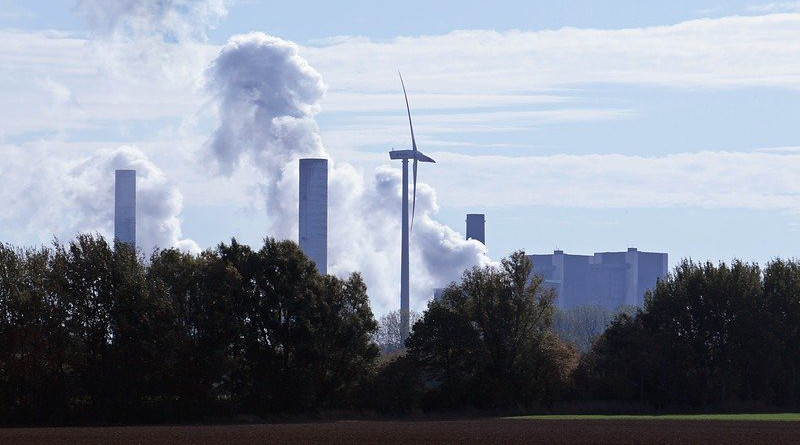COVID-19 And Clean Energy Transition In Caspian Region – Analysis
By CCEE
By Shahana Bilalova*
Background
COVID-19 has impacted all sectors in various ways and the energy sector is one of those which received significant shockwaves from the situation caused by this pandemic. Enhancement of the clean energy transition was on the agenda of all countries of the Caspian region which raises questions concerning the trends during and after COVID-19. To reflect on this, the current issue discusses the wider impacts of COVID-19 on the energy transition process in the countries of the Caspian region and introduces possible ways of navigating the process and achieving the targets set in the pre- pandemic phase.
Analysis
Renewable energy trends in the Caspian region
To expand the share of clean energy in the energy mix and to decrease the dependency of the energy sector on fossil fuels, the renewable energy sector in the Caspian region has experienced positive developments prior to the COVID-19 outbreak. Comparing the years of 2009 and 2017, all countries of the Caspian region excluding Turkmenistan had positive changes in total renewable energy capacity while for Turkmenistan the data for the capacity remains stable. Meanwhile, the same pattern follows for the total renewable energy production except for Azerbaijan in which total renewable energy production declined by 14 % comparing the years of 2009 and 2017 (Table 1).
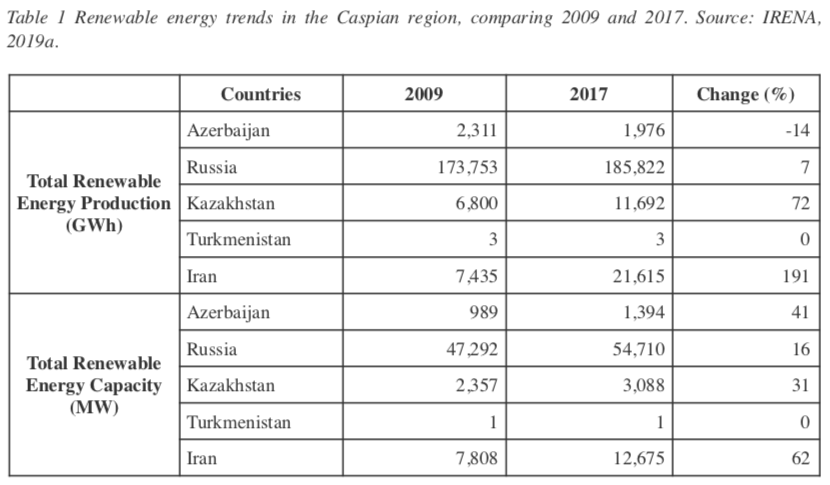
Despite the aforementioned positive developments, the shares of modern renewables in the total final energy consumption across the countries of the Caspian region for 2017 in comparison with 2000 have decreased with the exceptions of Turkmenistan and Iran. In this regard, while the shares of modern renewables in Azerbaijan and Russia have declined by 0.2 %, the decrease was 0.9 % in the case of Kazakhstan. On the contrary, while Turkmenistan has had a stable share of modern renewables in total final energy consumption, Iran has increased its share by 0.4 % over the years (Figure 1).
To enhance the share of renewables in the energy mix, three countries of the Caspian region – Azerbaijan, Russia, and Kazakhstan – have set targets on the expansion of current renewable energy production by 2030. Hereinafter, Azerbaijan is determined to increase its share of renewables in electricity production to 30 % by 2030 (2019b). Meanwhile, Russia aims at increasing its share of renewables in the total final energy consumption to 4.9 % by 2030 with the target of increasing its total renewable energy capacity (i.e. solar PV, onshore wind and geothermal energy) to 5.9 GW by 2024 (IRENA, 2017). Finally, Kazakhstan targets to reach 10 % concerning the share of renewables in the national energy mix by 2030 with the goal of reaching 50 % by 2050 (Samruk-Kazyna, 2018).
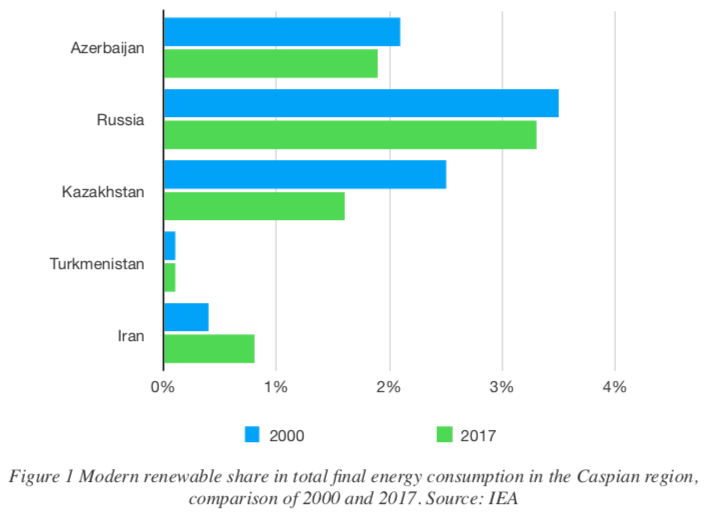
The recent years observed growing interest in the development and implementation of clean energy projects in the Caspian region including several ongoing and planned projects along with installments. In January 2020, the Ministry of Energy of the Republic of Azerbaijan made a deal with ACWA Power (the Kingdom of Saudi Arabia) and Masdar (the United Arab Emirates) for the implementation of renewable energy pilot projects in Azerbaijan. While Masdar is in charge of the development of a 200 MW solar power plant, ACWA Power will involve in the construction of a 240 MW wind farm (The Ministry of Energy, 2020). In addition, Khazar Offshore (1914 MW), Absheron (80 MW), Pirallahi Island Offshore (200 MW), Shurabad (84 MW) are among the planned projects to be implemented.
In Russia, the wind farm with the capacity of 1,823 MW to be commissioned before 2024 and two solar power plants with the capacities of 110 MW and 5.6 MW to be completed by 2022 are among the planned renewable projects to be launched within five years (Fortum, n.d.). In Kazakhstan, 28 solar energy projects with the installed capacity of 713.5 MW were planned to be commissioned by the end of 2020 based on the Ministry of Energy’s Plan of Activities for Alternative and Renewable Energy. Furthermore, nine renewable energy projects are planned to be launched by December 2020 within the framework of Kazakhstan’s latest effort to drive clean energy transition in the country. Finally, Iran Power Generation and Transmission Company (TAVANIR) pledged to provide 10 % of Iranian power by using renewable sources by 2021.
According to the report by World Economic Forum (2020), while Azerbaijan and Iran have increases in their Energy Transition Index (ETI) scores based on 2020 results compared to the year of 2018 results, both Russia and Kazakhstan experience a slight decline (Figure 2). ETI is an analytical framework developed by World Economic Forum for energy decision-makers to track transition towards more sustainable, secure and accessible energy systems (Singh et al., 2019). It measures the performance of the countries for their energy systems and transition readiness to sustainable and affordable energy future by centering around two key dimensions- energy system performance and transition readiness (World Economic Forum, 2020). Concerning system performance, both Azerbaijan and Russia had stable scores for 2018 and 2020, whereas Kazakhstan and Iran have experienced certain changes over the years. In this regard, while Iran improved its system performance by 5 %, Kazakhstan’s system performance has exacerbated comparing to 2018. Finally, the transition readiness index based on the results of 2018 and 2020 had a stable pattern in the cases of Kazakhstan and Iran while Azerbaijan (i.e. 1 % increase) and Russia (i.e. 1 % decrease) have had certain changes over the years.

Impact of COVID-19 on the energy sector
The coronavirus outbreak exacerbated financing challenges and policy uncertainty within the energy sector due to the declining energy demand, economic slow-down, industrial closure, and pressure on public budgets. Comparison with the first quarter of 2019, energy demand decreased by 3.8 % (150 million tonnes of oil equivalent (Mtoe)) followed by the slowed-down economic activity on a global level and milder weather conditions (IEA, 2020). The declining trend in demand was observed in all energy sources (e.g. coal (8 %), oil (5%) and natural gas (2%)) except for renewables which had an increase of 1.5 % in the first quarter of 2020 as a result of the output from the completed projects in previous years (IEA, 2020a). According to the projection of IEA (2020a), full-year energy demand might fall by 6 % as all energy sources except renewables are more likely to experience declines over the year (Figure 3). Contrarily, EIA (2020) forecasts that production and consumption of liquid fuels are projected to resume its increasing trend starting from the second quarter of 2020.

In a long run, deployment of renewable energy projects is projected to experience delays as a result of confinement measures, supply-chain disruptions, and financing obstacles while investment decisions for the projects under development might have suspension and cancellation as a result of macroeconomic challenges (IEA, 2020b). Lower energy demand, shortage of investment, disruption of supply chains, interrupted international technology diffusion, and policy exchange as a result of the coronavirus outbreak are major factors that will be destructive for renewable energy sector (Cherp and Jewell, 2020). IEA (2020b) estimates a 13 % decline in renewable electricity capacity in 2020 comparing to 2019. Similarly, EIA (2020) also forecasts that while renewables will be the fastest-growing source of electricity generation, generation capacity will be affected adversely in the following few months as a result of the COVID-19 related economic slowdowns.
The energy transition during low oil prices
Triggered by the fall in demand caused by the coronavirus outbreak and a lack of storage capacity for excess oil, oil prices experience declines despite slight rebounds (Figure 4).
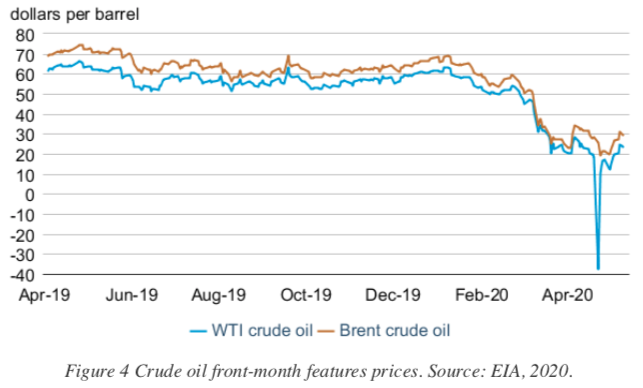
Recent lower oil prices have a major negative impact on the energy sector while causing delays in the energy transition. Firstly, lower oil prices are more likely to slow down energy transition including the expansion of zero-carbon initiatives (Krishnamoorti, 2020). Since lower oil prices lead to a decrease in incentive for achieving energy efficiency, it puts downward pressure on consumer interest on clean energy and electrification of vehicles making them less competitive.
Along with oil prices, natural gas prices are also in decline. Generally, natural gas is considered cleaner than coal and petroleum products. Despite renewable production cost has also declined over the decade as a result of factors such as technological improvement and economies of scale (IRENA, 2019a), the current decline in gas prices is a significant obstacle for the expansion of renewables in the absence of strong policies and outcompeted renewable costs.
Finally, as the governments’ priorities on public expenditure spending are shifted towards fighting against the causalities of the pandemic, financial resources available for clean energy transition including investments and subsidies are limited at the current stage. As a result, investment plans and projects in the pipeline targeting energy transition are more likely to be postponed and canceled. The same situation unfolds in the case of energy companies as issues such as employee safety, community health, and long-term profit are prioritized over environmental and corporate social responsibility related initiatives (Krishnamoorti, 2020).
The situation is even more volatile for the countries of the Caspian region as fuel revenue has a significant role in the economies of these countries. Concerning the data on merchandise exports, fuel export has more than 50 % share in all countries of the Caspian region highlighting the significance of the oil and gas revenues on the economy. Hereinafter, lower oil prices pose a significant obstacle for clean energy transition and public investment for the expansion of renewables in these countries under the current COVID-19 situation.
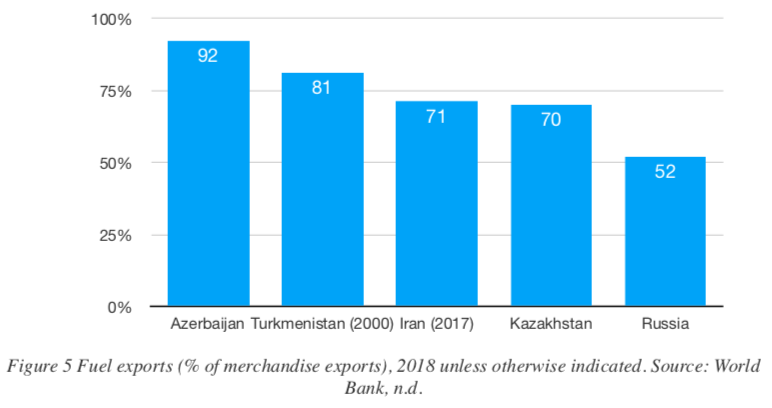
Navigating the clean energy transition
Exiting situation with the pandemic outbreak and lower oil prices makes energy transition complex and slow for the Caspian region countries. Whereas, the transition can be navigated by further governments’ efforts and international cooperation. Government policy strategies for post- coronavirus recovery can be built on the three major directions which are ensuring policy predictability and reassuring investors about energy and climate commitments; reduction of administrative barriers for the development of renewable project; and integration of renewables into recovery packages by introducing financial and cost-effective incentives and alignment of short-term policy actions with long-term emission reduction plans (IEA; 2020b). Along with government efforts, international cooperation is key in this transition. It can provide international flows of low-carbon investment, technology, and policy expertise and support fossil-fuel exporters to reform their energy subsidies (Cherp and Jewell, 2020).
The current crisis is an indicator of fragility of the existing energy systems relying on fossil fuels and signals the need for energy transition by building a more resilient system. In addition, the global community has certain commitments to meet concerning greenhouse gas emission (Table 2), thus the current situations should be transformed into an opportunity rather than perceived as an obstacle.
COVID-19 led economic slowdown and reduced fossil fuel consumption reflected itself in the emission reduction. The short-term trend should not be misinterpreted as a success since “well below 2̊C” Paris Agreement target requires countries to have long-term commitments. Therefore, post- COVID-19 recovery plans should be designed in line with an acceleration of energy transition.
*About the author: Shahana Bilalova, Research Associate, Caspian Center for Energy and Environment at ADA University
Source: This article was published by CCEE in Policy Brief June No. 39
References:
Cherp, A. and Jewell, J. (2020). COVID-19 weakens both sides in the battle between coal and renewables. Behavioural & Social Sciences. Available at https://socialsciences.nature.com/users/ 390808-aleh-cherp/posts/66644-by-disrupting-technology-diffusion- and-supply-chains-covid-19-may-harm-renewables-more-than-coal- but-still-weaken-coal-lock-in-in-developing-countries.
EIA. (2020). Short-Term Energy Outlook (STEO). Available at https://www.eia.gov/outlooks/steo/pdf/steo_full.pdf
IEA. (2020). Global Energy Review 2020. IEA: Paris. Available at https://www.iea.org/reports/global-energy-review-2020
IEA. (2020). Renewable energy market update, IEA: Paris. Available at https://www.iea.org/reports/renewable-energy-market- update
IRENA. (2017). REmap 2030 Renewable Energy Prospects for Russian Federation. Working paper. IRENA: Abu Dhabi.
IRENA. (2019). Renewable Energy Statistics 2019. The International Renewable Energy Agency: Abu Dhabi.
IRENA. (2019), Renewables Readiness Assessment: Azerbaijan. International Renewable Energy Agency: Abu Dhabi. Krishnamoorti, R. (2020). What Does The Oil Price Crisis Mean For The Energy Transition? Forbes. https://www.forbes.com/sites/ uhenergy/2020/03/13/what-does-the-oil-price-crisis-mean-for-the- energy-transition/#75a8effb5f44
Fortum. (n.d.). Wind and solar in Russia. Available at https:// www.fortum.com/about-us/media/press-kits/wind-and-solar-russia Samruk-Kazyna. (2018). Green Economy:Realities & Prospects in Kazakhstan. Available at https://www.sk.kz/upload/iblock/ 8d9/8d97878e7ec2466e04ab62e5d8f4c3a3.pdf
Singh, H. V., Bocca, R., Gomez, P., Dahlke, S., & Bazilian, M. (2019). The energy transitions index: An analytic framework for understanding the evolving global energy system. Energy Strategy Reviews, 26, 100382. https://doi.org/10.1016/j.esr.2019.100382 World Bank. n.d. Fuel exports (% of merchandise exports). Available at https://data.worldbank.org/indicator/ TX.VAL.FUEL.ZS.UN
World Economic Forum. (2018). Fostering Effective Energy Transition: A Fact-Based Framework to Support Decision-Making. Available at http://www3.weforum.org/docs/ WEF_Fostering_Effective_Energy_Transition_report_2018.pdf World Economic Forum. (2020). Fostering Effective Energy Transition: 2020 edition. Available at https://www.weforum.org/ reports/fostering-effective-energy-transition-2020

